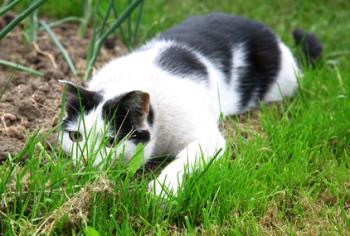Some time ago, we talked about the advantages and disadvantages of having an indoor cat versus an outdoor cat. We, as many other pet care professionals, agree that the indoors is a way, way, way safer place for a cat to be. But that does not necessarily mean that your cat shouldn’t enjoy a bit of outdoor life, too. In today’s article, you will learn about several good (and safe!) ways of letting an indoor cat go outside.
Before we talk about that, though, it’s only fair to weigh the benefits and decide whether there is a need for a cat to go outside in the first place.
Should I let my indoor cat go outside?

Question #1: Does your cat want to go outside? If your cat does not show interest in life on the other side of the door, then don’t force it. Most commonly, owners think of letting their cat go outdoors because their cat wants to. In such case, it could be useful for you to learn how to prevent a cat from escaping but still provide what your cat craves in a safe way.
Possible (but not guaranteed) advantages of letting an indoor cat go outside are fresh air, new stimuli, increased activity for your cat, sun exposure, fun for both the cat and the owner, and plant nibbling. This bring us to the next question.
Question #2: Can your location provide any of these benefits? The point is — there is nothing outdoors that your cat cannot live without. Moreover, there is nothing that, without it, your cat can’t enjoy life to the fullest — if you are willing to take part. Of course, if you think that your location can provide most of these advantages, why not give safely letting your cat outside a try?
How to provide safe outdoor access for an indoor cat
Here, we explain the four most common and convenient ways to let your cat outdoors without the risk of him or her getting into trouble. As you’ll see, these methods are different, so you can either choose one, or use several interchangeably.
NOTE: Whichever way you choose, make sure that you do not stress your cat. The outdoors is a lot different, and even if your cat shows curiosity about what’s behind the door, it’s still frightening. Let your cat outside for a very short time at first, and gradually let him or her enjoy the outdoors more and explore further. Whenever possible, make sure your cat has the ability to return home of his or her own will.
- Supervised outdoor time in a secure area. For example, if you have a garden, you can go outside with your cat. He or she won’t get into trouble if you are there, too, and keep him or her away from hazards. If your cat is on scheduled meals, you can let him or her outside before mealtime, which will make it easier to call him or her back. People whose cats are on scheduled meals often tell us that it only takes rattling a bowl or opening a can or fridge to get their cat to return. If you don’t feed your cat on schedule, then maybe it’s a good time to start. IMPORTANT: Bringing a cat outside and relying only on your supervision could be dangerous if you are not attentive. Your cat needs your undivided attention during this time. Make the outdoor trips short, and don’t leave your cat unsupervised. If your cat seems to get out of control, call him or her back using a treat. Otherwise, you will have an outdoor cat, which is not blameworthy but not safe, either.

Walking on a leash is probably the safest way of letting an indoor cat outside. Use a harness instead of a collar, though. - Take your cat on a leash. Seriously! Cats can be walked on a leash, and many enjoy it. For safety purposes, use a cat harness; do not attach the leash to a collar. Also, remember that your cat is not a dog and that you do not walk a cat on leash; your cat walks you. Seriously, don’t force your cat to do anything. Train your cat to accept the leash being on. Let your cat choose where to go, and follow him or her, using the leash simply to keep your cat away from danger, not directing him or her where to walk. Some cats might be stressed knowing that the leash prevents them from catching butterflies and climbing trees. You can overcome this by using a longer or even a very loooooong leash (look for retractable leashes made for small dogs) and by not forcing on your cat things he or she does not like.
- Outdoor cat enclosure. It’s a great and, most importantly, safe way to provide outdoor access to your cat. However, there are many very good and many very bad examples of outdoor cat enclosures. You have to remember that your cat is still confined, and seeing birds he or she cannot reach might cause unnecessary stress to your cat. Good examples are LARGE enclosures — the larger, the better — that are joined to the house and allow your cat free access at all times. Then, the enclosure is no longer confining; it’s just an extension of your house, making your cat’s “everyday confinement” (the house) larger and more interesting.
- Bringing the wild inside. “If the mountain won’t come to …” — Okay, never mind. We don’t mean that you should bring live mice and birds inside. You can, however, make some things available, like cat trees to climb, cat grass to nibble, and toys to bat. Most importantly, your cat needs to be active, and the best way to ensure this is to regularly play with him or her. Get an interactive toy, and have great fun every day for at least ten to fifteen minutes. There are many other ways to encourage activity without letting an indoor cat outside; all you need to do is to find the time.
Remember, we are not talking about whether your cat should be an indoor or outdoor cat. This is about safe ways to provide outdoor access to an indoor cat. If you think your cat might benefit from outdoor access, go for it. At least, try it, and see what happens.
